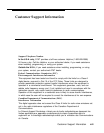
Customer Support Information
Security of Your System—Preventing Toll Fraud
As a customer of a new telephone system, you should be aware that there exists an
increasing problem of telephone toll fraud. Telephone toll fraud can occur in many
forms, despite the numerous efforts of telephone companies and telephone equipment
manufacturers to control it. Some individuals use electronic devices to prevent or
falsify records of these calls. Others charge calls to someone else’s number by
illegally using lost or stolen calling cards, billing innocent parties, clipping on to
someone else’s line, and breaking into someone else’s telephone equipment physically
or electronically. in certain instances, unauthorized individuals make connections to
the telephone network through the use of remote access features.
The Remote Access feature of your system, if you choose to use it, permits off-
premises callers to access the system from a remote telephone by using an 800
number or a 7- or 10-digit telephone number. The system returns an
acknowledgement signaling the user to key in his or her authorization code, which is
selected and administered by the system manager. After the authorization code is
accepted, the system returns dial tone to the user. If you do not program specific
egress restrictions, the user will be able to place any call normally dialed from a
telephone associated with the system. Such an off-premises network call is originated
at, and will be billed from the system location.
The Remote Access feature, as designed, helps the customer, through proper
administration, to minimize the ability of unauthorized persons to gain access to the
network. Most commonly, phone numbers and codes are compromised when
overheard in a public location, through theft of a wallet or purse containing access
information, or through carelessness (writing codes on a piece of paper and improperly
discarding it). Additionally, hackers may use a computer to dial an access code and
then publish the information to other hackers. Enormous charges can be run up
quickly. It is the customer’s responsibility to take the appropriate steps to properly
implement the features, evaluate and administer the various restriction levels, protect
access codes, and distribute access codes only to individuals who have been fully
advised of the sensitive nature of the access information.
Common carriers are required by law to collect their tariffed charges. While these
charges are fraudulent charges made by persons with criminal intent, applicable tariffs
state that the customer of record is responsible for payment of all long-distance or
other network charges. AT&T cannot be responsible for such charges and will not
make any allowance or give any credit for charges that result from unauthorized
access.
Customer Support Information xxiii


















